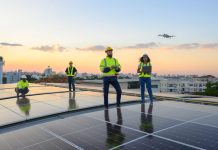
By Indiana Lee
Climate change is a growing concern that affects not only our planet but also our future. Countless research analyses and studies have illustrated a variety of consequences such as rising temperatures, extreme weather, and melting ice caps. Due to these issues, researchers have begun exploring new ways to combat climate change. One possible solution is atmospheric sun shading, which aims to reduce the effects of global warming.
What is Atmospheric Sun Shading?
You may have already heard of plenty of other solutions, but atmospheric sun shading is a relatively recent concept out of most climate change inventions. It’s also referred to as geoengineering or solar radiation and involves practices that reflect the sun’s energy away from the Earth, which inadvertently counters the effects of climate change if used in the long term.
This is done by releasing particles like sulfur dioxide into the Earth’s atmosphere, which can become a shield from the sunlight penetrating the Earth’s surface. This naturally occurs when volcanic particles create a temporary cooling effect after an eruption, but most practices of sun shading would be human-caused intervention.
Does Sun Sharing Work?
Although sun shading seems to address global warming, there are still lingering doubts about whether this method will work. While some researchers say it could help fight global warming and reduce the impact of extratropical storms, others found evidence that it could stimulate other effects of climate changes, such as ocean acidification and reduced rainfall.
With these mixed findings, there is still a long way to go before finding the most viable solution to help the environment without the threat of harming the planet.
Best Practices for Sun Shading
To effectively implement atmospheric sun shading, we must look at the most viable solutions for releasing sulfur aerosols into our atmosphere. Here are some of the best practices and steps that have been recommended:
- Stratospheric injection: Release sulfur aerosols into the stratosphere, where they can effectively scatter sunlight without causing immediate harm to the lower atmosphere.
- International collaboration: Coordinated efforts among countries and organizations are essential to monitoring and regulating the release of aerosols and ensuring safety.
- Continuous research: Ongoing research and monitoring are necessary to understand the long-term effects of atmospheric sun shading and make necessary adjustments.
The latter two steps are essential if we are to exceed sun shading’s potential.
Benefits of Sun Shading
Finding the best solution for climate change is not easy, and although sun shading is not perfect, it still offers some valuable benefits.
- Cooling the planet: The main benefit of sun shading is its potential to cool the planet. It does this by reflecting the sun’s rays away from Earth, which reduces global temperatures.
- Reducing extreme weather: Sun shading could have the potential to weaken extratropical storms, which can lead to less damage and a reduction of human suffering.
- Stabilizing agricultural production: By reducing extreme weather, agricultural systems could be stabilized, resulting in consistent food supplies.
- Preventing sea level rise: Lowering the global climate could slow the melting of polar ice caps, helping to avoid sea level rise.
These benefits showcase that sun shading is unique and will still require more research and observation to determine its effectiveness. However, it is essential to remember that although there are potential advantages, risks are also involved.
Risks of Sun Shading
While atmospheric sun shading holds promise, there are potential risks involved, as the process inherently involves changing storm patterns and tampering with natural climate systems. Research has found that this process needs to be diligently observed to avoid causing droughts or flooding rains. Additional risks include:
- Property damage: Altered storm tracks could lead to localized flooding and other weather-related damages, affecting homes, infrastructure, and communities.
- Regional climate disruption: Introducing sulfur aerosols into the atmosphere may disrupt local climate patterns, causing unforeseen consequences for agriculture, ecosystems, and daily life.
- Ethical concerns: Some argue that solar geoengineering may enable a ‘quick fix’ mentality, diverting attention from the root causes of climate change, such as reducing carbon emissions.
- Unpredictable outcomes: The long-term effects of atmospheric sun shading are still not fully understood, making it a challenging technique to implement globally.
While atmospheric sun shading may hold promise in tackling climate change, it should not be seen as a stand-alone solution but rather as one piece of a comprehensive approach towards creating a better future.
Alternative Solutions and The Future of Sustainability
The emerging trends and opportunities in sustainability continually shape our path to a more sustainable world. Some of these include:
- Reducing building emissions: Making buildings more energy-efficient and transitioning to renewable energy sources can significantly reduce greenhouse gas emissions. Some ways to reduce building emissions include improved insulation, solar panels, and wind turbines.
- Alternative fossil fuels: Developing and adopting alternative fossil fuels with lower carbon emissions, such as natural gas, can help reduce our reliance on traditional fossil fuels like coal and oil.
- Renewable energy sources: Sola and wind power are renewable energy sources that have minimal environmental impact as illustrated by the 2022 study published by Global Challenges. Transitioning to these sources can reduce carbon emissions and combat climate change.
- Sustainable transportation: Electric vehicles and public transportation systems powered by renewable energy can help reduce emissions from the transportation sector.
- Circular economy: Adopting a circular economy approach, where products are designed for longevity and recyclability, can significantly reduce waste and its negative environmental impact.
- Reforestation and afforestation: Planting trees and restoring forests can capture carbon dioxide from the atmosphere, helping to combat climate change and restore ecosystems.
- Urban farming initiatives: Urban agriculture programs encourage the planting of crops and food production in cities, reducing the environmental footprint of food transportation.
- Waste-to-energy facilities: These facilities turn non-recyclable waste into energy, reducing landfill waste and producing electricity or heat.
By embracing these trends and incorporating them into our daily lives, we can create a more sustainable future for the next generation, leading to a healthier environment and preserving our natural world.
Technology Solutions for Climate Change
Beyond these large initiatives, smaller initiatives should be embraced as well, and be a short-term solution as we seek to reduce our reliance on fossil fuel energy and conduct more research on sun shading practices. These solutions include:
- Remote working: Adopting remote working technologies reduces the need for commuting and office space, thereby cutting carbon emissions.
- Smart cities: Implementing smart technologies in cities can optimize energy use, transportation, and infrastructure, making urban areas more sustainable.
- Renewable energy integration: Advancements in energy storage and grid management make it easier to include renewable energy sources into the existing infrastructure.
- Sustainable agriculture: Technology is helping farmers optimize their practices, reduce waste, and conserve resources.
Embracing these technological advancements can help us combat the rising climate and create a more sustainable environment.
Atmospheric sun shading offers hope for our battle against climate change. However, it should not be seen as the only approach. We must also look to other strategies, such as alternative fossil fuels and sustainable agriculture. By embracing a wide variety of efforts, we can create a brighter future. So whether you are an individual, a community, or a government, let us work together towards a more sustainable future. We can do this by taking action and striving for a better world for everyone.
About the Author
 Indiana Lee is a writer, reader, and jigsaw puzzle enthusiast from the Pacific Northwest. An expert on business operations, leadership, marketing, and lifestyle, you can connect with her on LinkedIn.
Indiana Lee is a writer, reader, and jigsaw puzzle enthusiast from the Pacific Northwest. An expert on business operations, leadership, marketing, and lifestyle, you can connect with her on LinkedIn.



































